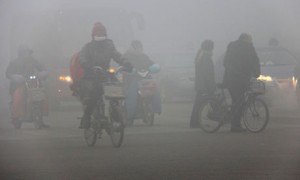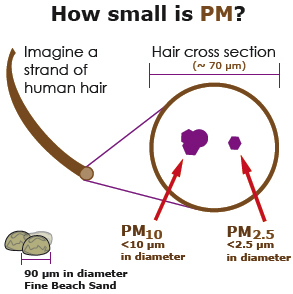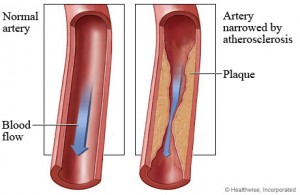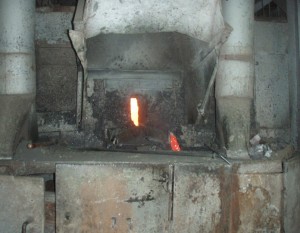Toxicology
Study: 2 Million Air Pollution Deaths Annually Worldwide, 77,000 in US
 We're a bit behind the curve in reporting on this, but scientists at the University of North Carolina just published a study in "Environmetnal Research Letters" that estimates Particulate Matter and Ozone pollution in the air is responsible for approximately 2.2 million deaths worldwide every year.
We're a bit behind the curve in reporting on this, but scientists at the University of North Carolina just published a study in "Environmetnal Research Letters" that estimates Particulate Matter and Ozone pollution in the air is responsible for approximately 2.2 million deaths worldwide every year.
Long-timers already know about how insidious Particulate Matter can be, but this only chronicles the hardcore fatal respiratory and cardiovascular impacts, concluding the tiny particles of soot cause at least 2.1 million deaths every year while ozone pollution shortens another 500,000 lives.
"East Asia," aka China, accounts for fully have of both those figures. India for another third. In North America, the casualties include 43,000 premature deaths from PM pollution and 33,000 from ozone.
Jason West, co-author of the study said: "Outdoor air pollution is an important problem and among the most important environmental risk factors for health."
Although alarming, these numbers are all underestimates of the health impacts of both of these pollutants, since they exclude anything other than fatalities. Besides making it harder to breathe, PM pollution has been linked to brain disorders and immune system disruptions.
New Studies Link Air Pollution to Cancer, Heart Failure and…Appendicitis?
 According to CBS News
According to CBS News
"A new study published July 10 in The Lancet showed that even breathing low levels of air pollution for a prolonged period of time could raise risk for the often-deadly lung disease. Another study released on the same date showed that short-term exposure to most major air pollutants could increase the risks of hospitalization and death from heart failure."
Lung cancer risks went up 18% with each increase of 5 migrograms of PM 2.5. Researchers noted that they did not find a level of pollution for where there was no risk, and the results indicated "the more the worse, the less the better" when it came to pollution.
"At this stage, we might have to add air pollution, even at current concentrations, to the list of causes of lung cancer and recognize that air pollution has large effects on public health," Takashi Yorifuji from the Okayama University Graduate School of Environmental and Life Science and Saori Kashima from Hiroshima University in Japan…."
A second study shows the risk of dying or going to the hospital because of heart failure increased by 3.52 percent for every 1 part per million increase of carbon monoxide levels; 2.36 percent for every increase of 10 parts per billion of sulfur dioxide; 1.7 percent for ever 10 parts per billion increase in nitrogen dioxide; and about 2 percent for every 10 micrograms per cubic meter increase of particulate matter. Surprisingly, increases in ozone were not linked to heart failure. Unsurprisingly, you're breahting in all of these kinds of air pollution if you live in DFW.
All of that is kind of old news – put stuff in air, see stuff harm your lungs and heart. But here's a new "adverse health effect" being linked to air pollution – appendicitis. While not as lethal as lung cancers and heart attacks, anyone who's had their appendix rupture can tell you it's not a pleasant experience.
And while ozone may not have been linked to heart problems in that previous study, the New York Times reports a Canadian one links it to a slight increase in your chances of having appendicitis.
High ozone levels were associated with an increased number of hospitalizations for appendicitis and were even more strongly associated with cases of burst appendix. For each 16 parts per billion increase in ozone concentration the scientists found an 11 to 22 percent increase in ruptured appendix cases. The study was published in Environmental Health Perspectives. The associations persisted after controlling for age, sex, season of the year and the presence of other air pollutants, like nitrogen dioxide and particulate matter. The reason for the association is unclear, but studies in mice have shown that air pollution can alter the animals’ abdominal bacteria.
Who knew?
PM Pollution From Coal Shortens Lives by 5 Years in China
 It's all over the place on the net, but just in case you missed it, it turns out that increasing the amount of Particulate Matter pollution results in more people getting killed or injured by that pollution. Shocking.
It's all over the place on the net, but just in case you missed it, it turns out that increasing the amount of Particulate Matter pollution results in more people getting killed or injured by that pollution. Shocking.
Sources of PM pollution include your car, your local gas well operation, cement plants, and in this particular case in Northern China, coal plants. Northern provinces that got free coal for heating had an average of 55% higher PM concentrations than those living in warmer climes and burning less coal. That resulted in a dramatic loss of life span tha averages just over 5 years, mostly due to cardio-circulatory problems.
This isn't all that hard to understand is it. You breathe air that goes into your lungs. Fill the air with soot, and you fill your lungs with it too. Fill your lungs with soot and your body has a hard time coping with extra crap in your lungs that isn't supposed to be there. When that happens your heart works overtime to compensate. Cause and effect.
Scientists keep telling us that, like lead, ANY exposure to this very fine soot that can lodge in your lungs is potentially harmful. There's no "safe" level of PM. Yet the EPA and the states still issue permits for the release of large quantities of this poison as if that weren't true. It's another depressing example of the science being far ahead of the regulations.
Another Study Links Autism to Air Pollution
 Women living in high air pollution areas while pregnant are up to twice as likely to have a child with autism as those living in low pollution areas, according to a study released June 18 by the National Institute of Environmental Health Sciences.
Women living in high air pollution areas while pregnant are up to twice as likely to have a child with autism as those living in low pollution areas, according to a study released June 18 by the National Institute of Environmental Health Sciences.
"What you see is the mothers with the 20 percent least exposure to pollutants, their children are least likely to have autism," lead researcher Dr. Andrea Roberts of the Harvard School of Public Health told The Standard-Times. "With each percentile of pollutant exposure, the presence of autism increased."
The study surveyed more than 300 women about the health of their children and compared the results to federal data on air pollution levels during the time and location of each mother's pregnancy. It's at least the second major study since March confirming a link between airborne pollution, but the evidence has been accumulating since 2006.
Autism is a disorder of brain development characterized by difficulty in social interaction, verbal and nonverbal communication and repetitive behaviors. Nationwide, 1 in 88 children have an autism spectrum disorder, according to the Center for Disease Control.
EPA Pushes Back Against Low-Dose Testing of Endocrine Disrupters
 Responding to a report last year that concluded the way EPA tests for harm from hormone-wrecking chemicals is out-of-date, the Agency itself published a review of its methodology last week that, not surprisingly, vindicated current practices.
Responding to a report last year that concluded the way EPA tests for harm from hormone-wrecking chemicals is out-of-date, the Agency itself published a review of its methodology last week that, not surprisingly, vindicated current practices.
In its annual "State of the Science" report, the EPA said that non-linear effects from exposure to endocrine disrupters have been documented, but concluded they were "rare" and did not constitute enough evidence to change the way the Agency assess toxic health harms.
“There currently is no reproducible evidence” that the low-dose effects seen in lab tests “are predictive of adverse outcomes that may be seen in humans or wildlife populations for estrogen, androgen or thyroid endpoints,” the agency report said. “Therefore, current testing strategies are unlikely to mischaracterize…a chemical that has the potential for adverse perturbations of the estrogen, androgen or thyroid pathways.”
Written by EPA officials with input from a team of scientists and managers from the Food and Drug Administration, the National Institute of Environmental Health Sciences and the National Institute of Child Health and Development, the draft was signed by Robert Kavlock, the EPA’s Deputy Assistant Administrator for Science.
Laura Vandenberg, the Tufts University researcher who headed up last year's study, "Hormones and Endocrine-Disrupting Chemicals: Low-Dose Effects and Nonmonotonic Dose Responses", responded by saying EPA's acknowledgement of endocrine disruption is a step forward, but added that the Agency had made some “odd, and possibly political decisions” in the new report.
"(The EPA's conclusions) fly in the face of our knowledge of how hormones work. They [endocrine disrupting chemicals] are overtly toxic at high doses but act like hormones, with completely different actions, at low doses.”
Vandenberg said the EPA used out-of-date studies on atrazine, when they should have used a new publication with dozens of authors from around the world showing the “consistent, low-dose effects of this chemical on amphibians, reptiles, fish, birds and mammals.”
Downwinders know that they are the recipients of low-level doses of hundreds, if not thousands of different chemicals trespassing into their lungs. They know that constant exposure to these chemicals, even at "safe levels" is harming them and their families. There are no computer models that can adequately reproduce what it's like to breath the air downwind of a waste-burning cement plant, a compressor station, or a trailer park masquerading as a lead smelter. Things happen on a molecular level that we are only now beginning to understand because we had no knowledge of the physiology of hormones or DNA when the toxicity tests EPA still uses were first imagined. Small stuff adds up.
But EPA is loath to admit this because it would mean turning the regulatory world upside down. If there are no "safe levels," there is no status quo. The system depends on the premise, however obsolete, that little bits of poison over a long period of time won't hurt most of us. It's this premise that Vendenberg and her colleagues were aiming at last year and it's this premise that EPA is defending in this newest report.
Learn About Local DIY Health Studies Tomorrow in Hour Call
 Our apologies for the late notice, but tomorrow, if you're available from 11 to 12 noon Dallas time, you can participate in a free national conference call to learn more about local health studies that citizens might be able to do or fund with guest speaker Gregory Howard, Assistant Professor of Environmental Studies at Dickerson College in Pennsylvania, who got his doctorate in epidemiology and toxicology from the highly-regarded Boston University of Public Health.
Our apologies for the late notice, but tomorrow, if you're available from 11 to 12 noon Dallas time, you can participate in a free national conference call to learn more about local health studies that citizens might be able to do or fund with guest speaker Gregory Howard, Assistant Professor of Environmental Studies at Dickerson College in Pennsylvania, who got his doctorate in epidemiology and toxicology from the highly-regarded Boston University of Public Health.
According to the Center's press release, citizens will be able to hear about "the range of possible community health studies, how to match an appropriate study to your community's concerns, and some benefits and pitfalls of different types of studies. During the call we'll provide access to a guide to assist groups and individuals in navigating the process of investigating environmental health problems in their communities. The brief presentation will be followed with an open conversation and Q&A about community health studies."
While there's no cost to participating, spaces on the call are limited, so sign up now here.
Particulate Matter (PM) Pollution Linked to Hardening of the Arteries
 Residents who live in more polluted parts of their town may have as much as a 2% greater risk of strokes and heart attacks than people who live in areas with cleaner air. That's the conclusion of a new study that specifically links PM 2.5 – that is soot or particulate matter that is 2.5 microns or less in size – to accelerating atherosclerosis, or hardening of the arteries.
Residents who live in more polluted parts of their town may have as much as a 2% greater risk of strokes and heart attacks than people who live in areas with cleaner air. That's the conclusion of a new study that specifically links PM 2.5 – that is soot or particulate matter that is 2.5 microns or less in size – to accelerating atherosclerosis, or hardening of the arteries.
Researchers from the University of Michigan School of Public Health and the University of Washington followed 5,362 people between the ages of 45 and 84 from six regions in the U.S.: Baltimore, Maryland, Forsyth County, North Carolina, Los Angeles County, California, Northern Manhattan and Southern Bronx, New York and St. Paul, Minnesota.
After accounting for behaviors like smoking, which can independently affect heart disease risk, they found that the thickness of the carotid arteries that supply blood to the head and neck increased by 14 µm each year. Participants who were exposed to higher levels of air pollution in their home had blood vessels that thickened faster compared to others living in their area with lower exposure levels.
Thickening of blood vessels is a sign of hardening of the arteries, as inflammation lures in clotting factors and other immune agents to patch up worn areas; as these compounds build, the vessels stiffen and thicken, losing their ability to flex and adjust to the varying levels of pressure created by the blood flow.
High levels of a fine air pollutant called PM2.5 was specifically linked with faster thickening of the inner two layers of the carotid artery, a vessel that serves as a sentinel for the state of other arteries throughout the body. However, the study also showed that if levels of PM2.5 were reduced in the participants’ homes, the pace of thickening slowed.
Workers are Frontline Downwinders Dying for That New Sofa
 Before you're initiated as a citizen into the reality of the politics of environmental health, before you lose your civics virginity, you want to believe such things are not possible. Surely things aren't that bad. The company wouldn't let it get that bad. The EPA wouldn't let it get that bad. Not in.. (fill-in the year) But more often than not, it IS that bad. And not just bad, but novel-worthy bad. Bad in ways you couldn't imagine when you started out. That's how bad this story is.
Before you're initiated as a citizen into the reality of the politics of environmental health, before you lose your civics virginity, you want to believe such things are not possible. Surely things aren't that bad. The company wouldn't let it get that bad. The EPA wouldn't let it get that bad. Not in.. (fill-in the year) But more often than not, it IS that bad. And not just bad, but novel-worthy bad. Bad in ways you couldn't imagine when you started out. That's how bad this story is.
Sheri Farley walks with a limp. The only job she could hold would be one where she does not have to stand or sit longer than 20 minutes, otherwise pain screams down her spine and up her legs.
“Damaged goods,” Ms. Farley describes herself, recalling how she recently overheard a child whispering to her mother about whether the “crippled lady” was a meth addict.
For about five years, Ms. Farley, 45, stood alongside about a dozen other workers, spray gun in hand, gluing together foam cushions for chairs and couches sold under brand names like Broyhill, Ralph Lauren and Thomasville. Fumes from the glue formed a yellowish fog inside the plant, and Ms. Farley’s doctors say that breathing them in eventually ate away at her nerve endings, resulting in what she and her co-workers call “dead foot.”
A chemical she handled — known as n-propyl bromide, or nPB — is also used by tens of thousands of workers in auto body shops, dry cleaners and high-tech electronics manufacturing plants across the nation. Medical researchers, government officials and even chemical companies that once manufactured nPB have warned for over a decade that it causes neurological damage and infertility when inhaled at low levels over long periods, but its use has grown 15-fold in the past six years.
Such hazards demonstrate the difficulty, despite decades of effort, of ensuring that Americans can breathe clean air on the job. Even as worker after worker fell ill, records from the Occupational Safety and Health Administration show that managers at Royale Comfort Seating, where Ms. Farley was employed, repeatedly exposed gluers to nPB levels that exceeded levels federal officials considered safe, failed to provide respirators and turned off fans meant to vent fumes.
There's an 8-minute film with Ms. Farley and other characters from the NYT story on the same page as the printed piece. Both are devastating in their directness. Everyday Farley and her co-workers would go to work and be enveloped in that yellow glue fog for 8-10 hour shifts. sometimes it only took weeks after being hired before the most severe neurological symptoms began to appear. This is in North Carolina, not China, or Mexico.
Even though the piece focuses on the workers at this one facility, what are the odds that people living adjacent to it were also being enveloped in the yellow glue fog? If a company doesn't care about its workers, it's not going to care about its neighbors either. Catch the warning about the harm of breathing in low levels of the glue over a long period of time?
There are many other takeaways from this piece, including
– How much attention OSHA pays to physical hazards that are well-understood like ladders and stairs, but not so much to chemicals in the workplace that affect us in more insidious ways – like robbing you of the use of your limbs.
– Why it's important to think things through to avoid a "Regrettable Substitute" like the yellow glue that was supposedly better for the ozone layer than what was formally used, but turned out to be a public health disaster on the ground. This is why we need the Precautionary Principle to test and verify the toxicity of the chemical BEFORE you release it into the marketplace. We know, completely radical idea.
– How ineffective "the system" was at protecting workers from chemical hazards that were way, way over the top – 860 times what the industry group recommended. And conversely, why workers need strong and effective unions to protect them.
Even if you think you've lost your ability to be shocked, this story will shock you.
Exide’s Crappy California Smelter Raising Cancer Risks
 We've linked to the sad and horrible stories coming from ex-employees of the Frisco Exide Lead smelter that paint a disturbing picture of what went on when the public and regulators weren't looking. But this is Texas, where you practially have to have dead bodies piled up along your fenceline to get the state to do much about polluters and their pollution. What might happen if Exide were to have a rogue smelter in less-polluter-hospitable place, like, say, California?
We've linked to the sad and horrible stories coming from ex-employees of the Frisco Exide Lead smelter that paint a disturbing picture of what went on when the public and regulators weren't looking. But this is Texas, where you practially have to have dead bodies piled up along your fenceline to get the state to do much about polluters and their pollution. What might happen if Exide were to have a rogue smelter in less-polluter-hospitable place, like, say, California?
A battery recycling plant in Vernon is being told to reduce its emissions after recent tests showed it is posing a danger to as many as 110,000 people living in an area that extends from Boyle Heights to Maywood and Huntington Park.
The South Coast Air Quality Management District announced late Friday that Exide Technologies, one of the largest battery recyclers in the world, must also hold public meetings later this spring to inform residents that they face an increased cancer risk and outline steps being taken to reduce it.
Air district officials said Exide's most recent assessment showed a higher cancer risk affecting a larger number of residents than any other of the more than 450 regulated facilities in Southern California over the 25-year history of a program to monitor toxic air contaminants. The primary contaminant in this case was arsenic.
There has been "nothing close to this … never," said Sam Atwood, spokesman for the air district.In a statement, Exide officials said they planned to work with the district on emissions reductions "that we expect will meet or exceed" requirements. "Exide takes its environmental responsibilities seriously…."
Yes, so seriously, they've waited until they got caught to address these arsenic emissions. According to the most recent estimates, the company is posing a risk of 156 cancers per million population. The EPA standard is one in a million.
Under California's regulations, when cancer risk from a facility reaches 10 per million, public notification is required. When it hits 25, facilities must take steps to reduce their emissions. Exide was six times over that limit.
Since the 1987 Toxic Hot Spots program went into effect, only about 20 facilities in Southern California have ever reported risks that were greater than 25 in 1 million. More than 95% of the facilities the air district regulates have risks under 10 in 1 million.
California will force Exide to produce a "Risk Reduction Plan" within 6 months that will have to outline how the company will reduce its arsenic emissions. Failure to do so could result in $25,000 a day fines and a shut down order from a judge.
Meanwhile, Exide is doing everything possible in Frisco to make sure that city will have lead-waste landfills along Stewart Creek and near downtown forever – refusing to remove the hazardous waste that's been found in them in favor of "treating" it in place in town and saying it wants to "cap" all the dumps and landfills, even though many are on slopes and one is even partially in the flood plain.
Our bet is that Exide will choose to close its California smelter rather than install state-of-the-art controls, and then Frisco will have yet another community to commiserate with over the company's toxic leftovers.
Study: Car Traffic As Bad As Second Hand Smoke in Causing Asthma
 A large new European study released this week found that as much as 14% of chronic children's asthma in the Continent's urban areas could be due to traffic pollution. That would put it on par with the effects of second-hand smoke, linked to anywhere from 4 to 18% of all childhood asthma.
A large new European study released this week found that as much as 14% of chronic children's asthma in the Continent's urban areas could be due to traffic pollution. That would put it on par with the effects of second-hand smoke, linked to anywhere from 4 to 18% of all childhood asthma.
"Air pollution has previously been seen to trigger symptoms but this is the first time we have estimated the percentage of cases that might not have occurred if Europeans had not been exposed to road traffic pollution," lead author Dr. Laura Perez, at the Swiss Tropical and Public Health Institute, said in a press release. "In light of all the existing epidemiological studies showing that road-traffic contributes to the onset of the disease in children, we must consider these results to improve policy making and urban planning."
Although the idea of getting cars off the road as a benefit of mass transit isn't new, this study and others that have been published recently flesh out a new public health concern about the immediate impacts of such reductions in the neighborhoods adjacent to highways. Often these neighborhoods are already low and moderate income, and/or minority-majority with higher-than-average asthma rates already institutionalized because of lack to access to care, poverty or other factors. Highway plannning has yet to take this kind of localized impact into account, especially in Texas and DFW, where regional highway builders are still salivating to build the Trinity Toll Road straight through the middle of Dallas or criss-cross Ft. Worth neighborhoods with the new "Chisholm Freeway."
Asthma affects one in 12 people, or 8 percent of the U.S. population, according to 2009 data from the Centers for Disease Control and Prevention. The number has increased since 2001, when one in 14 people were affected.
